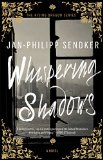Summary | Excerpt | Reviews | Beyond the Book | Read-Alikes | Genres & Themes | Author Bio

This article relates to Whispering Shadows
One of the key elements of Whispering Shadows features Westerners conducting business in China, in particular in Hong Kong and the Special Economic Zone of Shenzhen about 20 miles north of Hong Kong.
 Before being anointed as the first Special Economic Zone (SEZ) by then premier Deng Xiaoping in 1980, Shenzhen was an idyllic fishing village in Guangdong Province. But special status as an SEZ meant boom times with an annual growth rate of a whopping 28 percent (that rate slowed to 15 percent in 2005 and dropped further to 6.9 percent in 2015). The city was one of the anchors for China's booming economy, a mix of lax environmental regulations, large population of migrant workers and cheap land, attracting foreign investment. SEZs are defined as areas "where enterprises are treated more preferentially than in other areas in relation to such matters as the tax rate and the scope of operations in order to attract foreign capital and advanced technology for modernization." While the concept of SEZs are not new to the world, they were to 1980s China.
Before being anointed as the first Special Economic Zone (SEZ) by then premier Deng Xiaoping in 1980, Shenzhen was an idyllic fishing village in Guangdong Province. But special status as an SEZ meant boom times with an annual growth rate of a whopping 28 percent (that rate slowed to 15 percent in 2005 and dropped further to 6.9 percent in 2015). The city was one of the anchors for China's booming economy, a mix of lax environmental regulations, large population of migrant workers and cheap land, attracting foreign investment. SEZs are defined as areas "where enterprises are treated more preferentially than in other areas in relation to such matters as the tax rate and the scope of operations in order to attract foreign capital and advanced technology for modernization." While the concept of SEZs are not new to the world, they were to 1980s China.
A large surge in the number of migrant workers accompanied the rush of foreign investment and jobs in Shenzhen. The population rose from 30,000 in 1979 to 8.6 million in 2007 (75% of whom were classified as migrant workers, the unofficial tallies of migrant workers are often much larger). The boom in construction is mirrored by it becoming one of the largest container ports in the world.
 Unfortunately, even before the global economic crisis took firm root in 2008, Shenzhen, with its exploding population, shortage of resources and environmental contamination, was poised for a fall. As growth has declined sharply, China has tried to reposition Shenzhen as a center for innovation, with a focus away from manufacture to research and design. Unfortunately, the city continues to struggle under the weight of its own grand plans. As far back as 2006, in an article titled, "Chinese Success Story Chokes On Its Own Growth," The New York Times reported on a city that has seen an explosion in prostitution and other vices: "In Shenzhen's blue-collar neighborhoods, thick with fetid workers' dormitories, the frustration with hard labor, merciless factory bosses, low pay and miserable living conditions is palpable." Not all is gloom and doom however. The expansion of the middle class is perhaps strongest in Shenzhen, the article reported, a middle class that is increasingly refusing to take authoritarian rule lightly.
Unfortunately, even before the global economic crisis took firm root in 2008, Shenzhen, with its exploding population, shortage of resources and environmental contamination, was poised for a fall. As growth has declined sharply, China has tried to reposition Shenzhen as a center for innovation, with a focus away from manufacture to research and design. Unfortunately, the city continues to struggle under the weight of its own grand plans. As far back as 2006, in an article titled, "Chinese Success Story Chokes On Its Own Growth," The New York Times reported on a city that has seen an explosion in prostitution and other vices: "In Shenzhen's blue-collar neighborhoods, thick with fetid workers' dormitories, the frustration with hard labor, merciless factory bosses, low pay and miserable living conditions is palpable." Not all is gloom and doom however. The expansion of the middle class is perhaps strongest in Shenzhen, the article reported, a middle class that is increasingly refusing to take authoritarian rule lightly.
The first four SEZs were established in proximity to Hong Kong, Macau and Taiwan. Now there are over 30, strategically located along China's coastline, on the borders to China's many neighbors and on the Yangtze River.
Picture of East Pacific Center Towers in Shenzhen by Jo Sau
Picture of Shenzhen container port by What's On Xiamen
Filed under Places, Cultures & Identities
![]() This "beyond the book article" relates to Whispering Shadows. It originally ran in April 2015 and has been updated for the
February 2016 paperback edition.
Go to magazine.
This "beyond the book article" relates to Whispering Shadows. It originally ran in April 2015 and has been updated for the
February 2016 paperback edition.
Go to magazine.
Music is the pleasure the human mind experiences from counting without being aware that it is counting
Click Here to find out who said this, as well as discovering other famous literary quotes!
Your guide toexceptional books
BookBrowse seeks out and recommends the best in contemporary fiction and nonfiction—books that not only engage and entertain but also deepen our understanding of ourselves and the world around us.